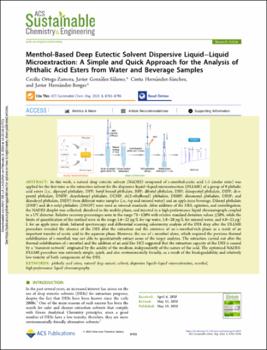Menthol-based deep eutectic solvent dispersive liquid-liquid microextraction: a simple and quick approach for the analysis of phthalic acid esters from water and beverage samples
Fecha
2020Resumen
In this work, a natural deep eutectic solvent (NADES) composed of L-menthol: acetic acid 1:1 (molar ratio) was applied for the first time as the extraction solvent for the dispersive liquid−liquid microextraction (DLLME) of a group of 9 phthalic acid esters (i.e.,dipropyl phthalate, DPP; butyl benzyl phthalate, BBP; dibutyl phthalate, DBP; diisopentyl phthalate, DIPP; di-n pentyl phthalate, DNPP; dicyclohexyl phthalate, DCHP; di(2-ethylhexyl) phthalate, DEHP; diisononyl phthalate, DINP; and diisodecyl phthalate, DIDP) from different water samples (i.e., tap and mineral water) and an apple juice beverage. Dihexyl phthalate (DHP) and di-n-octyl phthalate (DNOP) were used as internal standards. After addition of the DES, agitation, and centrifugation, the NADES droplet was collected, dissolved in the mobile phase, and injected in a high-performance liquid chromatograph coupled to a UV detector. Relative recovery percentages were in the range 71−120% with relative standard deviation values ≤20%, while the limits of quantification of the method were in the range 3.6−22μg/L for tapwater,3.8−20μg/L for mineral water, and 4.0−23μg/ L for an apple juice drink. Infrared spectroscopy and differential scanning calorimetry analysis of the DES drop after the DLLME procedure revealed the absence of the DES after the extraction and the existence of an L-menthol-rich phase as a result of an important transfer of acetic acid to the aqueous phase. However, the use of L-menthol alone, which required the previous thermal solubilization of L-menthol, was notable to quantitatively extract some of the target analytes. The extraction carriedout after the thermal solubilization of L-menthol and the addition of an acid like HCl suggested that the extraction capacity of the DES is caused by a “transient network” originated by the acidity of the medium, independently of the nature of theacid. The optimized NADES DLLME procedure was extremely simple, quick, and also environmentally friendly, as a result of the biodegradability and relatively low toxicity of both components of the DES.





